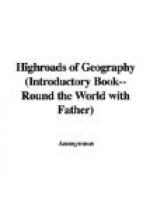10. The drivers ring bells, or shout to warn the people: “Hi, you woman with the baby on your hip, get out of the way!—Hi, you man with the box on your head, get out of the way!”
11. I think you would like to see the bullock carts. They are very small, and are drawn by two bullocks with humps on their shoulders. The driver sits on the shaft and steers them with a stick. These carts carry cotton to the mills or to the docks.
[Illustration: {A bullock cart}]
12. In some of the carriages and motor cars you may see rich men wearing fine silk robes. Many of these rich men now dress as we do, except that they wear turbans instead of hats.
* * * * *
11. In the streets.
1. I should like you to see the shops of Bombay. Most of them are quite unlike our British shops. They have no doors and no windows, but are open to the street.
2. Our shopkeepers try to make a fine show of their goods. The Indian shopkeeper does nothing of the sort. He simply piles his goods round his shop and squats in the midst of them. There he sits waiting for people to come and buy.
[Illustration: {An Indian shopkeeper}]
3. In our shops there is a fixed price for the goods. In India nothing has a fixed price. You must bargain with the shopkeeper if you wish to buy anything. Very likely he will ask you three times the price which he hopes to get.
4. Our penny is divided into four parts; each of these parts is called a farthing. The Indian penny is divided into twelve parts; each of these parts is called a “pie.” An Indian boy or girl can buy rice or sweets with one pie.
5. There are thousands of beggars in India. They go to and fro in front of the shops begging. The shopkeepers are very kind to them, and never send them away without a present.
6. Very good order is kept in the streets. At every street corner stands a native policeman, dressed in blue, with a flat yellow cap on his head and a club by his side. Some of the policemen ride horses, and carry guns and lances.
[Illustration: {An Indian policeman}]
7. The parks of Bombay are large open spaces covered with grass. Round them are rows of palm trees. In these parks you may see men and boys playing all sorts of games.
8. Indians are very fond of cricket, which they play very well. Not many years ago an Indian prince was one of the best players in England.
9. Polo is also played in the parks of Bombay. It is an Indian game, but Britons now play it too. Polo is just hockey on horseback.
10. The players ride ponies which are very quick and nimble. Each player carries a mallet with a very long handle. With this mallet he strikes a wooden ball and tries to drive it between the goal posts.
11. Last night I stopped to watch some Indian boys playing marbles. When Tom plays the game, he places the marble between his thumb and forefinger and shoots it out with his thumb.




